2007 CHEVROLET EXPRESS CARGO VAN heater
[x] Cancel search: heaterPage 95 of 458
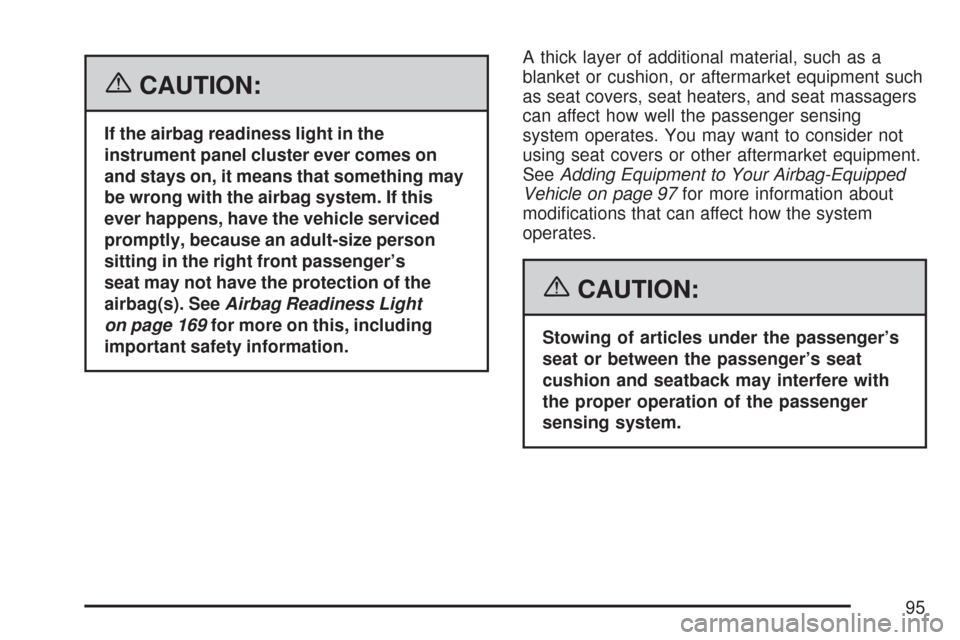
{CAUTION:
If the airbag readiness light in the
instrument panel cluster ever comes on
and stays on, it means that something may
be wrong with the airbag system. If this
ever happens, have the vehicle serviced
promptly, because an adult-size person
sitting in the right front passenger’s
seat may not have the protection of the
airbag(s). SeeAirbag Readiness Light
on page 169for more on this, including
important safety information.A thick layer of additional material, such as a
blanket or cushion, or aftermarket equipment such
as seat covers, seat heaters, and seat massagers
can affect how well the passenger sensing
system operates. You may want to consider not
using seat covers or other aftermarket equipment.
SeeAdding Equipment to Your Airbag-Equipped
Vehicle on page 97for more information about
modifications that can affect how the system
operates.
{CAUTION:
Stowing of articles under the passenger’s
seat or between the passenger’s seat
cushion and seatback may interfere with
the proper operation of the passenger
sensing system.
95
Page 101 of 458
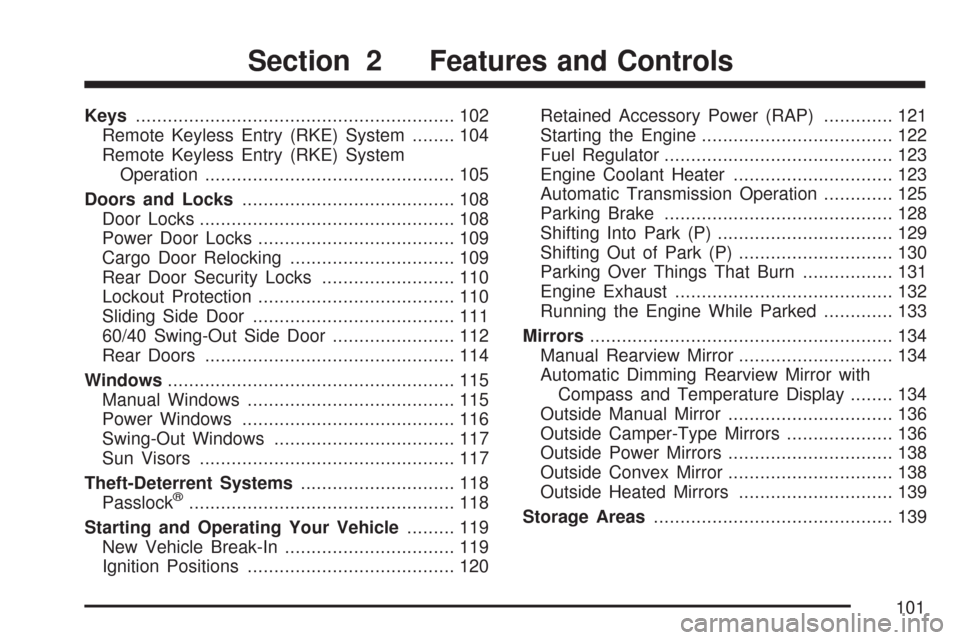
Keys............................................................ 102
Remote Keyless Entry (RKE) System........ 104
Remote Keyless Entry (RKE) System
Operation............................................... 105
Doors and Locks........................................ 108
Door Locks................................................ 108
Power Door Locks..................................... 109
Cargo Door Relocking............................... 109
Rear Door Security Locks......................... 110
Lockout Protection..................................... 110
Sliding Side Door...................................... 111
60/40 Swing-Out Side Door....................... 112
Rear Doors............................................... 114
Windows...................................................... 115
Manual Windows....................................... 115
Power Windows........................................ 116
Swing-Out Windows.................................. 117
Sun Visors................................................ 117
Theft-Deterrent Systems............................. 118
Passlock
®.................................................. 118
Starting and Operating Your Vehicle......... 119
New Vehicle Break-In................................ 119
Ignition Positions....................................... 120Retained Accessory Power (RAP)............. 121
Starting the Engine.................................... 122
Fuel Regulator........................................... 123
Engine Coolant Heater.............................. 123
Automatic Transmission Operation............. 125
Parking Brake........................................... 128
Shifting Into Park (P)................................. 129
Shifting Out of Park (P)............................. 130
Parking Over Things That Burn................. 131
Engine Exhaust......................................... 132
Running the Engine While Parked............. 133
Mirrors......................................................... 134
Manual Rearview Mirror............................. 134
Automatic Dimming Rearview Mirror with
Compass and Temperature Display........ 134
Outside Manual Mirror............................... 136
Outside Camper-Type Mirrors.................... 136
Outside Power Mirrors............................... 138
Outside Convex Mirror............................... 138
Outside Heated Mirrors............................. 139
Storage Areas............................................. 139
Section 2 Features and Controls
101
Page 123 of 458
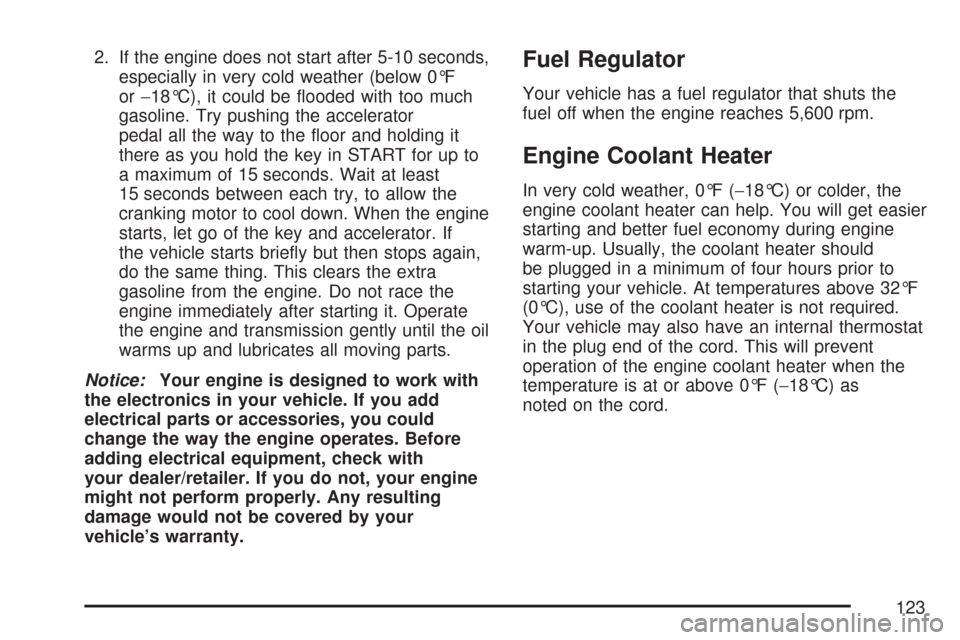
2. If the engine does not start after 5-10 seconds,
especially in very cold weather (below 0°F
or−18°C), it could be flooded with too much
gasoline. Try pushing the accelerator
pedal all the way to the floor and holding it
there as you hold the key in START for up to
a maximum of 15 seconds. Wait at least
15 seconds between each try, to allow the
cranking motor to cool down. When the engine
starts, let go of the key and accelerator. If
the vehicle starts briefly but then stops again,
do the same thing. This clears the extra
gasoline from the engine. Do not race the
engine immediately after starting it. Operate
the engine and transmission gently until the oil
warms up and lubricates all moving parts.
Notice:Your engine is designed to work with
the electronics in your vehicle. If you add
electrical parts or accessories, you could
change the way the engine operates. Before
adding electrical equipment, check with
your dealer/retailer. If you do not, your engine
might not perform properly. Any resulting
damage would not be covered by your
vehicle’s warranty.Fuel Regulator
Your vehicle has a fuel regulator that shuts the
fuel off when the engine reaches 5,600 rpm.
Engine Coolant Heater
In very cold weather, 0°F (−18°C) or colder, the
engine coolant heater can help. You will get easier
starting and better fuel economy during engine
warm-up. Usually, the coolant heater should
be plugged in a minimum of four hours prior to
starting your vehicle. At temperatures above 32°F
(0°C), use of the coolant heater is not required.
Your vehicle may also have an internal thermostat
in the plug end of the cord. This will prevent
operation of the engine coolant heater when the
temperature is at or above 0°F (−18°C) as
noted on the cord.
123
Page 124 of 458
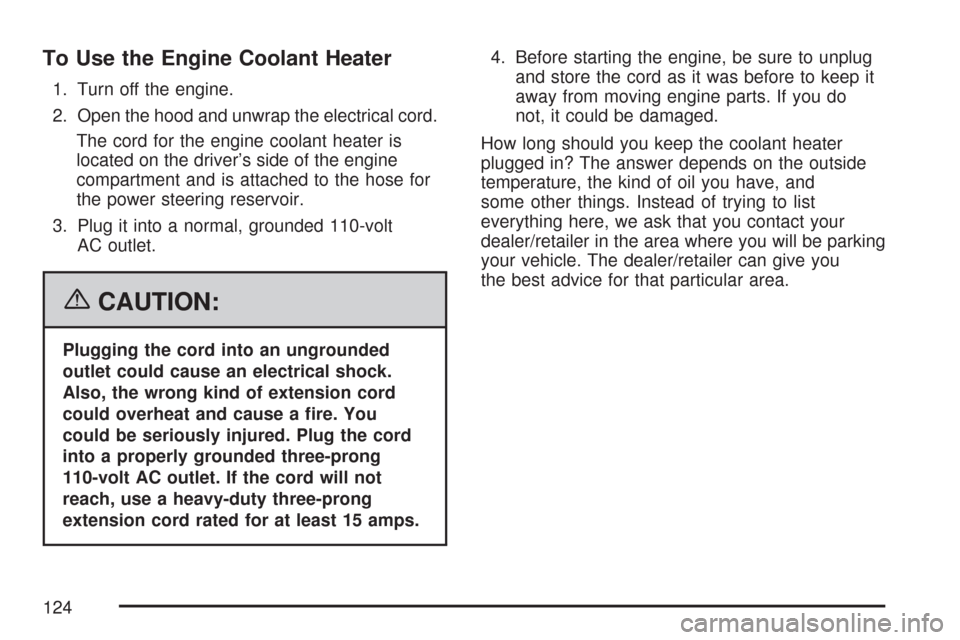
To Use the Engine Coolant Heater
1. Turn off the engine.
2. Open the hood and unwrap the electrical cord.
The cord for the engine coolant heater is
located on the driver’s side of the engine
compartment and is attached to the hose for
the power steering reservoir.
3. Plug it into a normal, grounded 110-volt
AC outlet.
{CAUTION:
Plugging the cord into an ungrounded
outlet could cause an electrical shock.
Also, the wrong kind of extension cord
could overheat and cause a �re. You
could be seriously injured. Plug the cord
into a properly grounded three-prong
110-volt AC outlet. If the cord will not
reach, use a heavy-duty three-prong
extension cord rated for at least 15 amps.4. Before starting the engine, be sure to unplug
and store the cord as it was before to keep it
away from moving engine parts. If you do
not, it could be damaged.
How long should you keep the coolant heater
plugged in? The answer depends on the outside
temperature, the kind of oil you have, and
some other things. Instead of trying to list
everything here, we ask that you contact your
dealer/retailer in the area where you will be parking
your vehicle. The dealer/retailer can give you
the best advice for that particular area.
124
Page 132 of 458
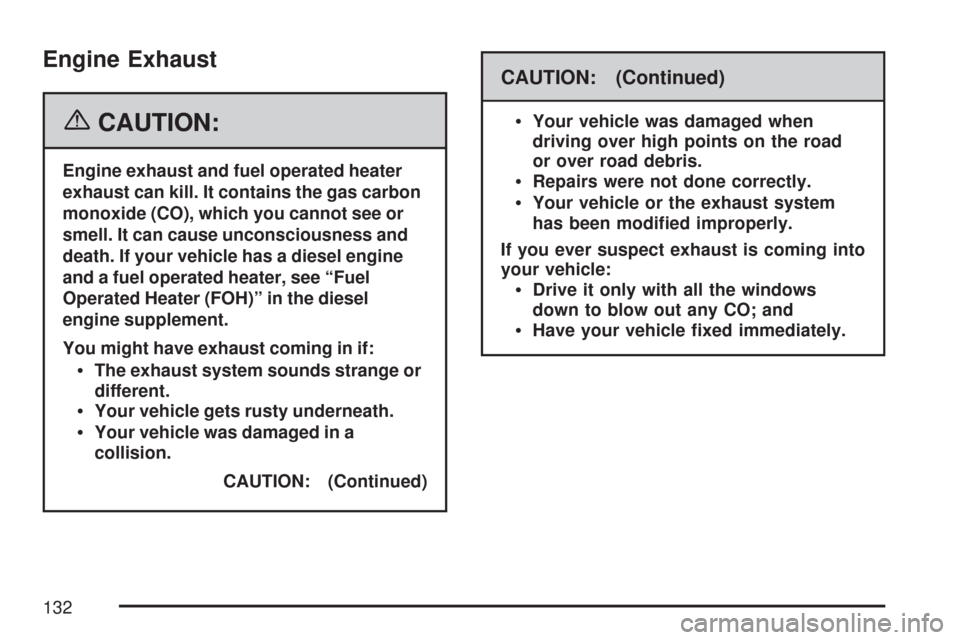
Engine Exhaust
{CAUTION:
Engine exhaust and fuel operated heater
exhaust can kill. It contains the gas carbon
monoxide (CO), which you cannot see or
smell. It can cause unconsciousness and
death. If your vehicle has a diesel engine
and a fuel operated heater, see “Fuel
Operated Heater (FOH)” in the diesel
engine supplement.
You might have exhaust coming in if:
The exhaust system sounds strange or
different.
Your vehicle gets rusty underneath.
Your vehicle was damaged in a
collision.
CAUTION: (Continued)
CAUTION: (Continued)
Your vehicle was damaged when
driving over high points on the road
or over road debris.
Repairs were not done correctly.
Your vehicle or the exhaust system
has been modi�ed improperly.
If you ever suspect exhaust is coming into
your vehicle:
Drive it only with all the windows
down to blow out any CO; and
Have your vehicle �xed immediately.
132
Page 259 of 458
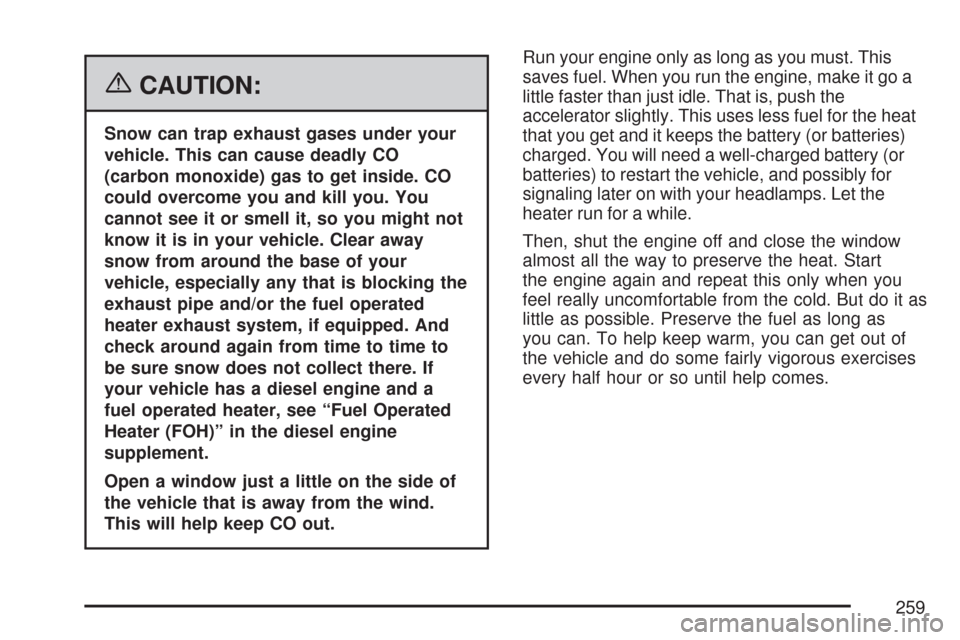
{CAUTION:
Snow can trap exhaust gases under your
vehicle. This can cause deadly CO
(carbon monoxide) gas to get inside. CO
could overcome you and kill you. You
cannot see it or smell it, so you might not
know it is in your vehicle. Clear away
snow from around the base of your
vehicle, especially any that is blocking the
exhaust pipe and/or the fuel operated
heater exhaust system, if equipped. And
check around again from time to time to
be sure snow does not collect there. If
your vehicle has a diesel engine and a
fuel operated heater, see “Fuel Operated
Heater (FOH)” in the diesel engine
supplement.
Open a window just a little on the side of
the vehicle that is away from the wind.
This will help keep CO out.Run your engine only as long as you must. This
saves fuel. When you run the engine, make it go a
little faster than just idle. That is, push the
accelerator slightly. This uses less fuel for the heat
that you get and it keeps the battery (or batteries)
charged. You will need a well-charged battery (or
batteries) to restart the vehicle, and possibly for
signaling later on with your headlamps. Let the
heater run for a while.
Then, shut the engine off and close the window
almost all the way to preserve the heat. Start
the engine again and repeat this only when you
feel really uncomfortable from the cold. But do it as
little as possible. Preserve the fuel as long as
you can. To help keep warm, you can get out of
the vehicle and do some fairly vigorous exercises
every half hour or so until help comes.
259
Page 295 of 458
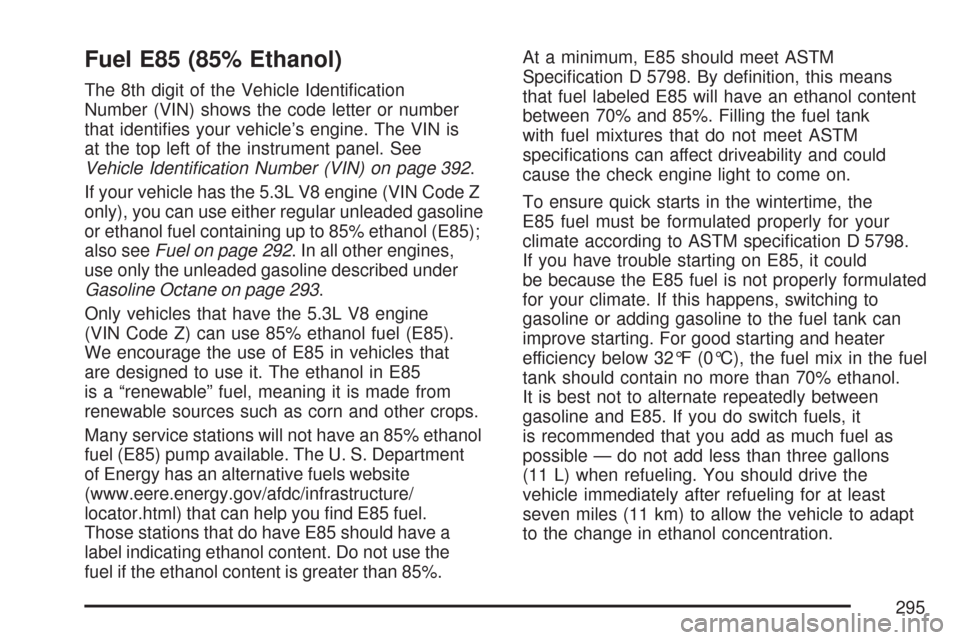
Fuel E85 (85% Ethanol)
The 8th digit of the Vehicle Identification
Number (VIN) shows the code letter or number
that identifies your vehicle’s engine. The VIN is
at the top left of the instrument panel. See
Vehicle Identi�cation Number (VIN) on page 392.
If your vehicle has the 5.3L V8 engine (VIN Code Z
only), you can use either regular unleaded gasoline
or ethanol fuel containing up to 85% ethanol (E85);
also seeFuel on page 292. In all other engines,
use only the unleaded gasoline described under
Gasoline Octane on page 293.
Only vehicles that have the 5.3L V8 engine
(VIN Code Z) can use 85% ethanol fuel (E85).
We encourage the use of E85 in vehicles that
are designed to use it. The ethanol in E85
is a “renewable” fuel, meaning it is made from
renewable sources such as corn and other crops.
Many service stations will not have an 85% ethanol
fuel (E85) pump available. The U. S. Department
of Energy has an alternative fuels website
(www.eere.energy.gov/afdc/infrastructure/
locator.html) that can help you find E85 fuel.
Those stations that do have E85 should have a
label indicating ethanol content. Do not use the
fuel if the ethanol content is greater than 85%.At a minimum, E85 should meet ASTM
Specification D 5798. By definition, this means
that fuel labeled E85 will have an ethanol content
between 70% and 85%. Filling the fuel tank
with fuel mixtures that do not meet ASTM
specifications can affect driveability and could
cause the check engine light to come on.
To ensure quick starts in the wintertime, the
E85 fuel must be formulated properly for your
climate according to ASTM specification D 5798.
If you have trouble starting on E85, it could
be because the E85 fuel is not properly formulated
for your climate. If this happens, switching to
gasoline or adding gasoline to the fuel tank can
improve starting. For good starting and heater
efficiency below 32°F (0°C), the fuel mix in the fuel
tank should contain no more than 70% ethanol.
It is best not to alternate repeatedly between
gasoline and E85. If you do switch fuels, it
is recommended that you add as much fuel as
possible — do not add less than three gallons
(11 L) when refueling. You should drive the
vehicle immediately after refueling for at least
seven miles (11 km) to allow the vehicle to adapt
to the change in ethanol concentration.
295
Page 300 of 458
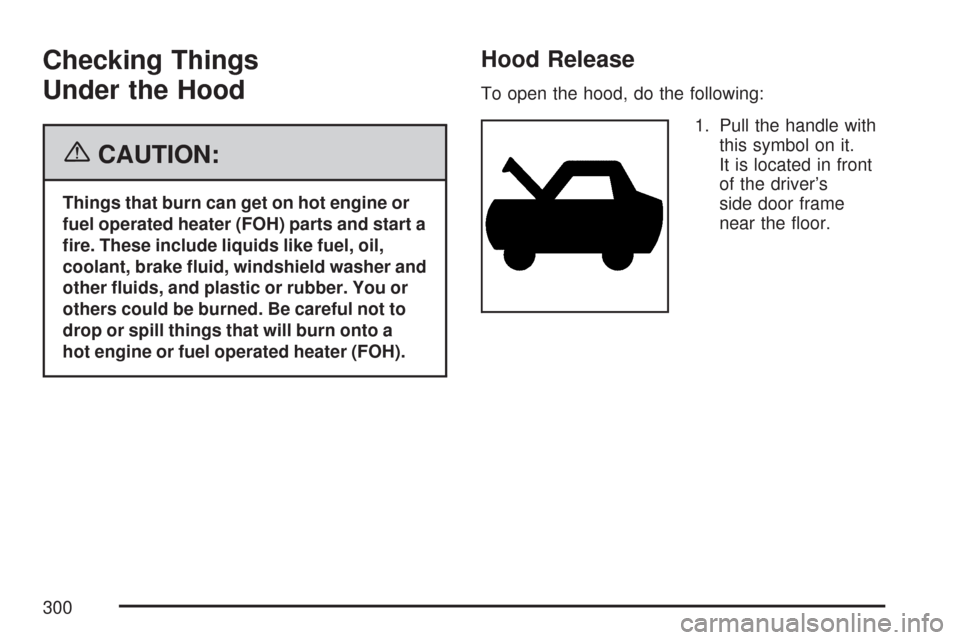
Checking Things
Under the Hood
{CAUTION:
Things that burn can get on hot engine or
fuel operated heater (FOH) parts and start a
�re. These include liquids like fuel, oil,
coolant, brake �uid, windshield washer and
other �uids, and plastic or rubber. You or
others could be burned. Be careful not to
drop or spill things that will burn onto a
hot engine or fuel operated heater (FOH).
Hood Release
To open the hood, do the following:
1. Pull the handle with
this symbol on it.
It is located in front
of the driver’s
side door frame
near the floor.
300